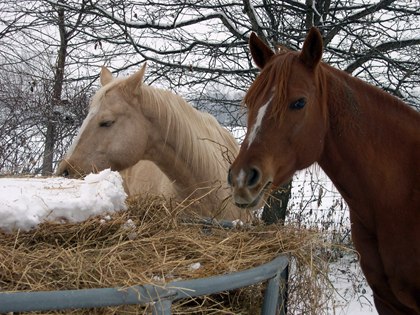Winter can be a worrying time for horse owners as they battle the elements, and one of the most distressing ailments experienced by horses during this season is the onset of colic.

What are the different types of colic?
Colic can occur in two forms; impaction colic and spasmodic colic. Impaction colic is basically the accumulation of dried feed in the horse’s bowel. The bolus usually gets stuck in the narrowest part of the colon and can cause a partial or complete obstruction which is incredibly painful, and will cause the horse to sweat profusely, become restless, paw the ground, turn to look at and/or kick his flanks, and repeatedly try to roll on the ground.
Spasmodic colic is often the result of a horse having consumed excess grain which produces an accumulation of gas and a distended stomach. This is again extremely painful for the horse, and he will likely be sweating, pawing and attempting to roll. Rolling itself could lead to displacement colic, or ‘twisted gut’, where the intestine in the distended abdomen twist and risk strangulation or rupture. Both impaction and spasmodic colic require immediate veterinary treatment, so if you think that your horse is exhibiting any symptoms, call your practice immediately.
Why is colic more common in winter?
It is thought that there are several factors that can bring on a bout of colic, all of which are aggravated in the colder months. Winter colic is vastly due to dietary changes that can unbalance a horse’s sensitive gut, and as the temperatures change, so too does the exercise regime and lifestyle of your horse. During winter, horses have less grazing and more grains and are typically stabled for extended periods of time. This means that they have reduced water intake, reduced movement and lower quality forage, and these factors can all affect gut activity and contribute to colic.
What can I do to help my horse?
The pain experienced by a horse suffering with colic is severe, and their symptoms will become more extreme as the colic progresses. After calling the vet, try to keep your horse moving by walking him gently to help relieve trapped gas and encourage intestinal movement. This also helps to keep his mind off the pain and prevents him from rolling which could lead to further complications as mentioned above.
If he is too weak or is trying to roll then you need to place him in a secure, sturdy stable where he can safely move around and lie down if he needs to. The stable walls must be reinforced with strong panelling to withstand any kicks if he does roll, and ideally provide a deep fluffy bed with extra high banks to prevent him from getting cast.
What can I do to prevent colic?
To prevent colic, remember the three F’s: Forage, Feed and Fresh Water. Try to feed the highest quality hay or haylage you can to replace the forage that your horse would usually enjoy in the fields. This will aid digestion and increase calorie intake, and by increasing the calories through forage, you will then be able to significantly reduce their hard feed. Horses are notorious for drinking less during the winter, plus they are not receiving water from the grazing, so soak your horse’s hay nets thoroughly to make the forage more palatable and aid hydration, alongside access to plenty of fresh, not frozen water troughs and buckets.

